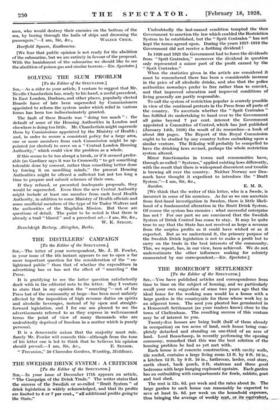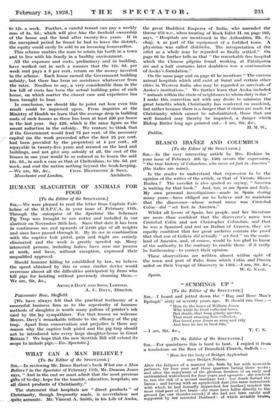THE HOMECROFT SETTLEMENT [To the Editor of the SPECTATOR.] SIR,—You
have published articles and correspondence from time to time on the subject of housing, and we particularly recall your own suggestion of some two years ago that the ideal home for the working man would be a house with a large garden in the countryside for those whose work lay in an adjacent town. The seed you planted has germinated in a Homecroft Settlement (as your readers know) close to the town of Cheltenham. The resulting success of this venture may be of interest to you.
Twenty-five houses are being built (half of them already in occupation) on ten acres of land, each house being com- pletely detached and standing on one-third of an acre of land. Lord Beauchamp, in recently performing the opening ceremony, remarked that this was the best solution of the housing problem he had as yet met with.
Each house is of concrete construction, with cavity walls, tile roofed, contains a large living room 15 ft. by 9 ft. 10 in., a kitchen 12 ft. by 9 ft. 10 in., bathroom, larder, coal store, earth closet, back porch, 8 ft. staircase and three good bedrooms with large hanging cupboard upstairs. Each garden has an outbuilding with compartments for fowls, rabbits, goat and tool shed.
The rent is 12s. 6d. per week and the rates about 2s. The large garden to each house can reasonably be expected to save at least 2s. ad. per week on the household expenses, thus bringing the average of weekly rent, or its..,_n:_xsilegt, to 12s. a week. Further, a careful tenant can pay a weekly sum of 3s. 3d., which will give him the freehold ownership of the house and the land after twenty-five years. If in the unexpired period he found he had to leave the district, the equity could easily be sold to an incoming homecrofter.
This scheme enables the man to retain his berth in a town and to live with his family in a healthy environment.
All the expenses and Costs, preliminary and in building, have worked out in such a manner that the 12s. 6d. per week rent pays a 5 per cent. return on the money invested in the scheme. Each house earned the Government building subsidy, but there has been no assistance whatsoever from the rates. Needless to say, a very considerable item in the low bill of costs has been the actual building price of each house, on which matter the closest care and experience has been brought to bear.
In conclusion, we should like to point out how even this result could be improved upon. From inquiries at the Ministry of Health we learn that the average drop in building costs of such houses as these has been at least 130 per house in the last year. Say £20, which is the same figure as the recent reduction in the subsidy. We venture to think that if the Government would lend 75 per cent. of the necessary capital (as the work proceeded after the first 25 per cent. bad been provided by the proprietor) at 4 per cent., all repayable in twenty-five years and secured on the land and buildings, and not give any subsidy at all, the cost of the houses in one year would be so reduced as to lessen the said 12s. 6d., in such a case as that at Cheltenham, to 10s. 6d. per week, and cost the nation nothing beyond the book-keeping.
—We are, Sir, &e., CHAS. HEATHCOTE & SONS,
Manchester and London. Architects.







































 Previous page
Previous page